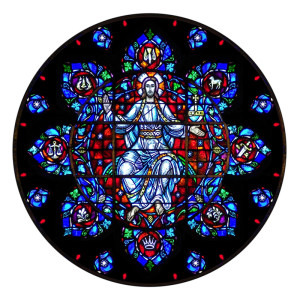This is a truly beautiful and excellent Christian Mandala. It is saturated with Christian symbols. The basic structure is a large central circle with eight surrounding petals. Note how Christ is fully rendered in the center commanding the largest amount of area. The surrounding petals are much smaller and rely completely on symbols.
I am serious, this is really good. It is located in Boston Universities’ Marsh Chapel and was built about 65 years ago.
We begin in the central area. We see Christ seated on a cosmic throne. The seated position indicates authority. The Nimbus (halo) behind His head reminds us of His Divinity. Above Christ’s left hand there is a round object with a cross on top. This is a globe that signifies Christ’s sovereignty over the world.
Note also the five pointed stars inside the main circle. Outside the main circle the stars have eight points. I plan to return to this in Part 5C.
Inside the large circle that completely surrounds Christ is a ring with a smaller diameter. This ring is thinner and is light blue to green in color. This ring is special. It travels behind the head of Christ, behind his right hand, and under his feet. It is a vine. Off this main vine, which is connected to our glorious enthroned King, hang clusters of grapes. Other vines shoot off this main vine ring and extend out into the eight petals. Fresh green and bluish leaves hang off the secondary vines.
Visually notice how the vines connect the region inside the larger circle to the surrounding area containing the symbols in each of the eight petals. The vines, grapes, and leaves represent the Church, joined together with Christ. This is a visual representation of Jesus’ I AM statement: “I Am the true vine.”
It is possible to read the heavenly vegetation and grapes as suggesting the Marriage Supper of the Lamb. I don’t think this interpretation makes sense due to the presence of the empty scales and the broken sword symbols. These symbols suggest a time period after the marriage feast.
In Part 5B we explore the scale and broken sword symbols together with the other symbols in the eight petals outside the main circle.
In Part 5C we will return to the number eight which is very prominent in the image and take a closer look at a few more subtle symbols in the image.

